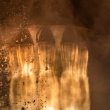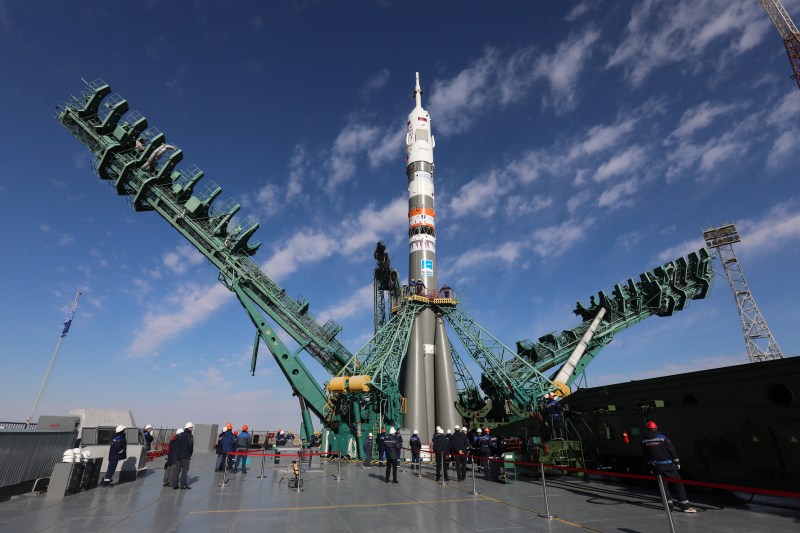Featured image credit: ROSCOSMOS
Lift Off Time | February 24, 2023 – 00:24:29 UTC | 03:24:29 MSK |
|---|---|
Mission Name | Soyuz MS-23, uncrewed flight to the International Space Station (ISS) |
Launch Provider | ROSCOSMOS |
Customer | ROSCOSMOS |
Rocket | Soyuz 2.1a |
Launch Location | Launch Complex 31/6, Baikonur Cosmodrome, Kazakhstan |
Payload mass | 7,050 kg (15,540 Ib) (for the whole spacecraft) |
Where did the spacecraft go? | It rendezvoused with the ISS, ~400 km low Earth orbit (LEO) at a 51.66° inclination |
Did they attempt to recover the first stage? | No, this is not a capability of Soyuz |
Where did the first stage land? | The boosters crashed into the steppes of Kazakhstan |
Did they attempt to recover the fairings? | No, this is not a capability of Soyuz |
Are these fairings new? | Yes |
This was the: | – 2nd Soyuz 2.1a mission in 2023 – 67th Soyuz 2.1 a mission overall – 3rd launch from the Baikonur Cosmodrome of 2023 – 27th orbital launch attempt of 2023 |
Where to re-watch | Official replay |
How Did It Go?
ROSCOSMOS successfully launched the uncrewed Soyuz MS-23 mission to the International Space Station (ISS) on February 24, 2023. Unlike other Soyuz MS missions, this one did not aim to bring new cosmonauts to the ISS but to replace the Soyuz MS-22 spacecraft that suffered a thermal control system leak on the ISS on December 15, 2022. ROSCOSMOS launched this mission using a Soyuz MS spacecraft atop a Soyuz 2.1a launch vehicle, from Launch Complex 31/6, at the Baikonur Cosmodrome in Kazakhstan.
Initially, this launch was scheduled for February 20, 2023. However, after the depressurization of the thermal control system of the Progress MS-21 spacecraft, which took place on February 11 at the ISS, ROSCOSMOS took time to analyze the telemetric information and images of the outer surface of the spacecraft. They also inspected in detail the radiator on the Soyuz MS-23 and did not find any damage to it.
Soyuz MS-23 Mission
Original Plan
Initially, the Soyuz MS-23 mission was intended to bring Oleg Kononenko (ROSCOSMOS, Commander), Nikolai Chub (ROSCOSMOS, Flight Engineer), and Loral O’Hara (NASA, Flight Engineer) to the ISS on March 16, 2023. However, the plans were drastically changed due to the issue in the docked Soyuz MS-22 spacecraft that could not perform the return of the current crew and reentered the Earth unmanned. The original crewed flight will be reassigned to the Soyuz MS-24. mission.
Current Plan
The main goal of the Soyuz MS-23 mission is to replace the Soyuz MS-22 spacecraft that was launched on September 21, 2022, with Sergey Prokopyev (Commander), Dmitry Petelin (Flight Engineer 1), and Francisco Rubio (Flight Engineer 2) aboard, but was damaged on the ISS. The version of technical damage to the spacecraft during the manufacturing process was not confirmed. According to Sergei Krikalev, the executive director for human spaceflight at ROSCOSMOS, the issue occurred in the cooling system due to an object of ~1 mm puncturing a hole in the external cooling loop of the spacecraft. The diameter of the hole is less than 1 mm. It cannot be determined whether this was a micro-meteoroid or a small piece of orbital debris. Therefore, the crew that would have flown in the damaged Soyuz MS-22 vehicle will use this Soyuz MS-23 spacecraft instead.

There were no cosmonauts aboard the Soyuz MS-23 spacecraft; instead, it delivered 429 kg of supplies for the current crew to the ISS. Therefore, this Soyuz MS played a role of a Progress MS spacecraft. Among this cargo was equipment for medical examination, station cleaning, air purity and composition control, and water supply. Moreover, the mission brought materials and instruments for several experiments, including Interaction-2, Matreshka-R, Cardiovector, MSK-2, Cascade, Fagen, and Probiovit. The uncrewed spacecraft also delivered some replacement equipment for the systems of the Russian segment, landing and maintenance equipment, means of support for the crew, supplies for preventing the adverse effects of weightlessness, sanitary-hygienic products, and containers with food rations.
Soyuz MS-23 Mission’s Profile
The Soyuz MS-23 docked to the ISS (Poisk module) on February 26, at 00:58 UTC (03:58 MSK).
Approximate Timeline (Based On The Soyuz MS-18 Mission)
| Hrs:Min:Sec From Lift-Off | Events |
| – 00:00:15 | Engine start sequence |
| 00:00:00 | Lift-Off |
| + 00:01:53 | Escape tower jettison |
| + 00:01:58 | First stage separation |
| + 00:02:33 | Fairing jettison |
| + 00:04:47 | Second stage separation |
| + 00:04:55 | Tail section separation |
| + 00:08:46 | Third stage main engine cutoff |
| + 00:08:49 | Soyuz MS separation |
What Is Soyuz 2.1a?
ROSCOSMOS’s Soyuz is a multi-use medium-lift launch vehicle that was introduced in far 1966 and since then has been the workhorse of the Soviet/Russian space program. It is capable to launch civilian and military satellites, as well as cargo and crewed missions to the ISS. Over the decades, several variants of the Soyuz rocket have been developed. Soyuz 2.1a is one of its latest iterations that belongs to the Soyuz-2 rocket family.
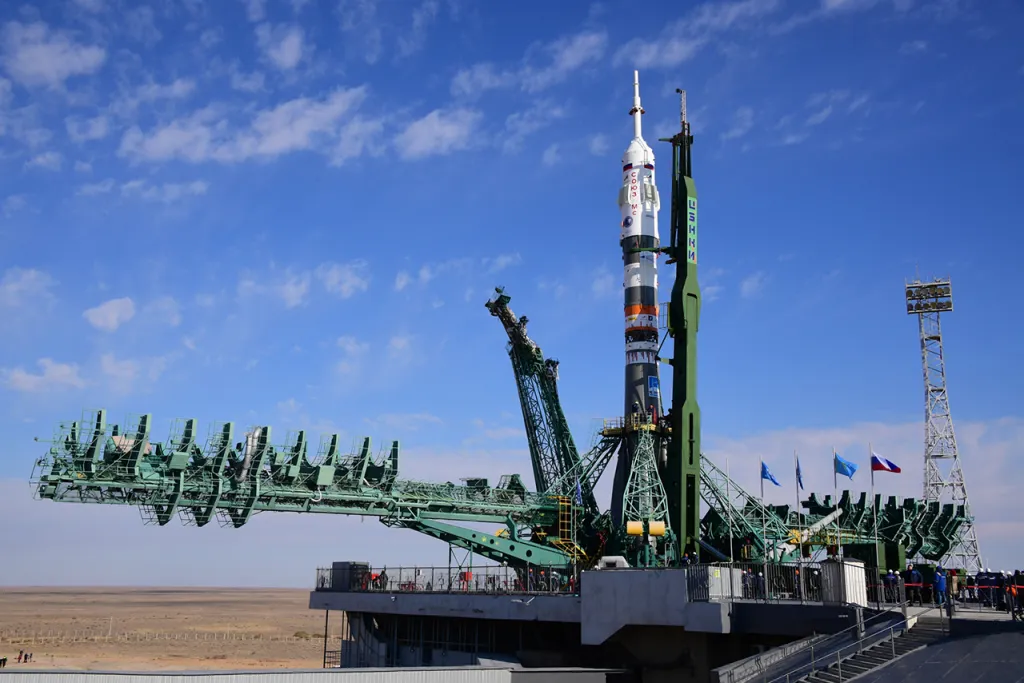
The rocket consists of three stages, all of them are expendable. When launching to the ISS, Soyuz-2 can be flown with either a Progress capsule or a Soyuz spacecraft. On the Soyuz MS-23 mission, the Soyuz MS spacecraft was used.
Soyuz 2.1a is about 46.3 meters (152 ft) in height and 2.95 meters (9 feet) in diameter. The vehicle’s total lift-off mass is approximately 312,000 kg (688,000 lb). The rocket’s payload lift capacity to low-Earth orbit (LEO) is between 6,600 and 7,400 kg depending on the launch site.
Stages
| First Stage | Second Stage | Third Stage | |
| Engine | 4 RD-107A | RD-108A | RD-0110 |
| Total Thrust | 840 kN (188,720 lbf), sea level 1,020 kN (229,290 lbf), vacuum | 792 kN (178,140 lbf), sea level 922 kN (207,240 lbf), vacuum | 298 kN (67,000 lbf), vacuum |
| Specific Impulse (ISP) | 263 s, sea level 320 s, vacuum | 258 s, sea level 321 s, vacuum | 326 s, vacuum |
Side Boosters
The first stage of the Soyuz 2.1a rocket is composed of four side boosters that are powered by RD-107A engines. Each one of the boosters has a conical shape and a dry weight of 3,784 kg. It is approximately 19.6 meters in length, with a diameter of 2.7 meters. Each side booster has two vernier thrusters that are used for flight control.
The RD-107A engine runs on rocket-grade kerosene (RP-1) and liquid oxygen (LOx). The propellants are stored in the pressurized aluminum alloy tanks, the kerosene tank is located in the cylindrical part of the booster, and the LOx one is in the conical section. Each one of those engines has four combustion chambers and together they are capable of producing a thrust of 840 kN at sea level and 1,020 kN in a vacuum.
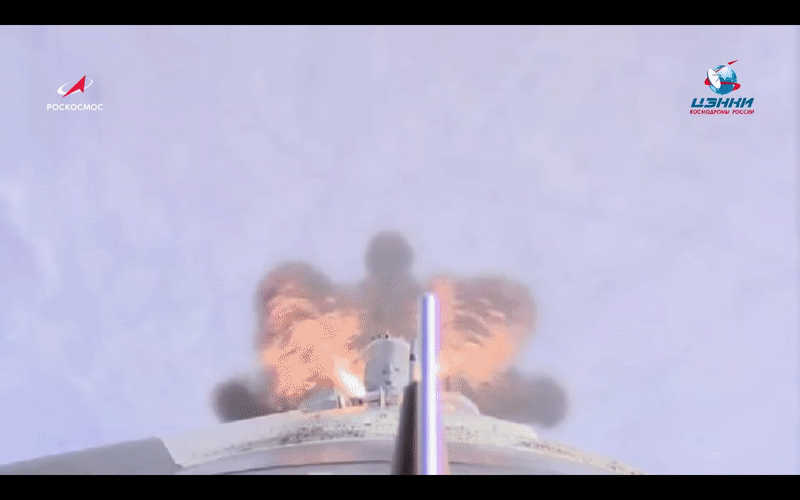
Perhaps, the most spectacular moment of the Soyuz-2 rocket’s launch is the separation of the first stage. It happens approximately two minutes after the launch. The boosters perform a pattern, known as the “Korolev cross” (named after Sergei Korolev, a very important figure of the USSR space program and history).
Second And Third Stages
The center core stage is powered by a single RD-108A engine, and the upper stage is fitted with a single RD-0110 engine. Both of these engines run on rocket-grade kerosene and LOx and have four combustion chambers. The second stage is 27.10 meters long, with a diameter of 2.95 meters, and a dry mass of 6,545 kg. It has four vernier thrusters for three-axis flight control.
The third stage of a Soyuz-2 rocket has a height of 6.7 meters, a diameter of 2.7 meters, and a dry mass of 2,355 kg. One interesting thing about the engine on this stage is that it starts its ignition sequence prior to stage separation. This process is called “hot fire staging”.
Soyuz MS Spacecraft
The Soyuz MS spacecraft is the latest version of Russia’s long-standing three-person spacecraft. Soyuz capsules first flew in the 1960s. The spacecraft’s external appearance is largely unchanged over this time. However, the internal systems and capabilities have been upgraded many times.

The Soyuz MS variant is one of the versions from the fourth generation of this spacecraft. Its first flight was in 2006. Soyuz consists of three sections:
- the orbital module
- the descent module
- the service module
The Orbital Module
This is the forward section of the spacecraft, the part that docks to the ISS. It is the part of the spacecraft where the crew will spend most of their time on orbit. It has more living room than the descent module. On the Progress uncrewed resupply missions, this is replaced by a cargo module.
The Descent Module
This is the middle section of the spacecraft. It is the only part that returns intact to land on Earth. This is where the crew will sit during the launch and the reentry. They will be wearing spacesuits in case of capsule depressurization. There is very little room for the crew of three in this module. On the Progress uncrewed resupply missions, this is replaced by a refueling module that can transfer fuel into the Russian segment. This can then be used by thrusters on the ISS to boost its orbit.
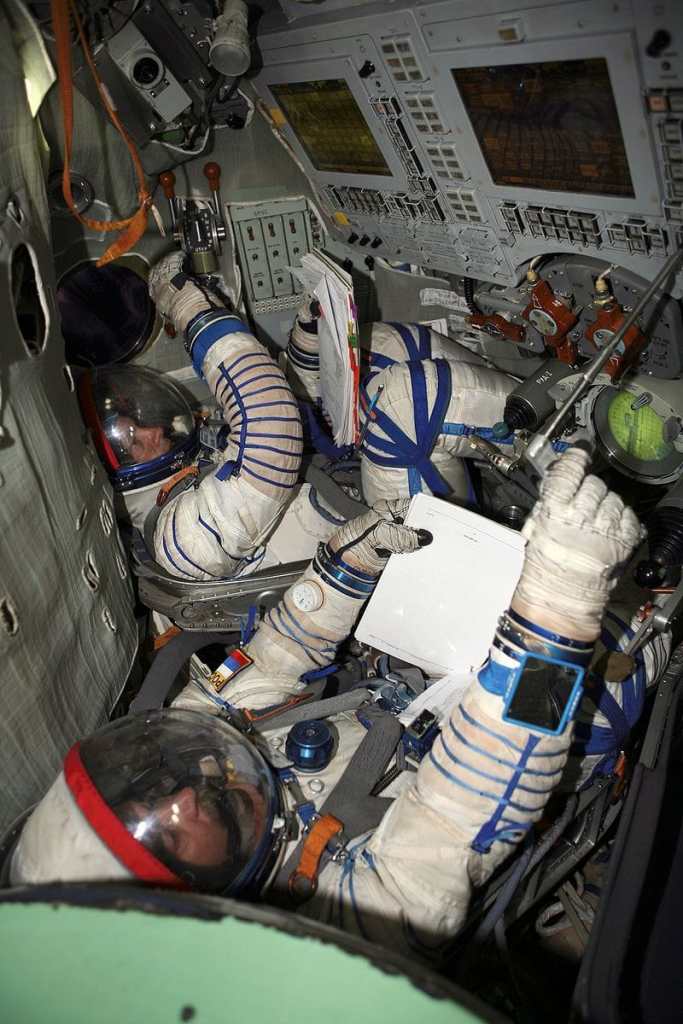
The Service Module
This is the aft (rear) section of the spacecraft. It provides the main engine used for manoeuvring on orbit and the thrusters for fine control during docking and departure. Also, it also contains the life support system for environmental control of the rest of the spacecraft. In addition, it also supports the solar panels and various radio communication systems.
Kurs-NA Automatic Docking System
Like the Soyuz spacecraft, Progress MS is equipped with a Kurs-NA automatic docking system that was first tested on the Progress M-15M mission in July 2012. Compared to its ancestor, Kurs-A, the new system has only one AO-753A rendezvous antenna. Kurs-A had five (two 2AO-VKA and three AKR-VKA) of them. This antenna broadcasts radar pulses that are needed to determine the altitude and relative position of the spacecraft to the ISS. Moreover, Kurs-NA uses less power than Kurs-A.
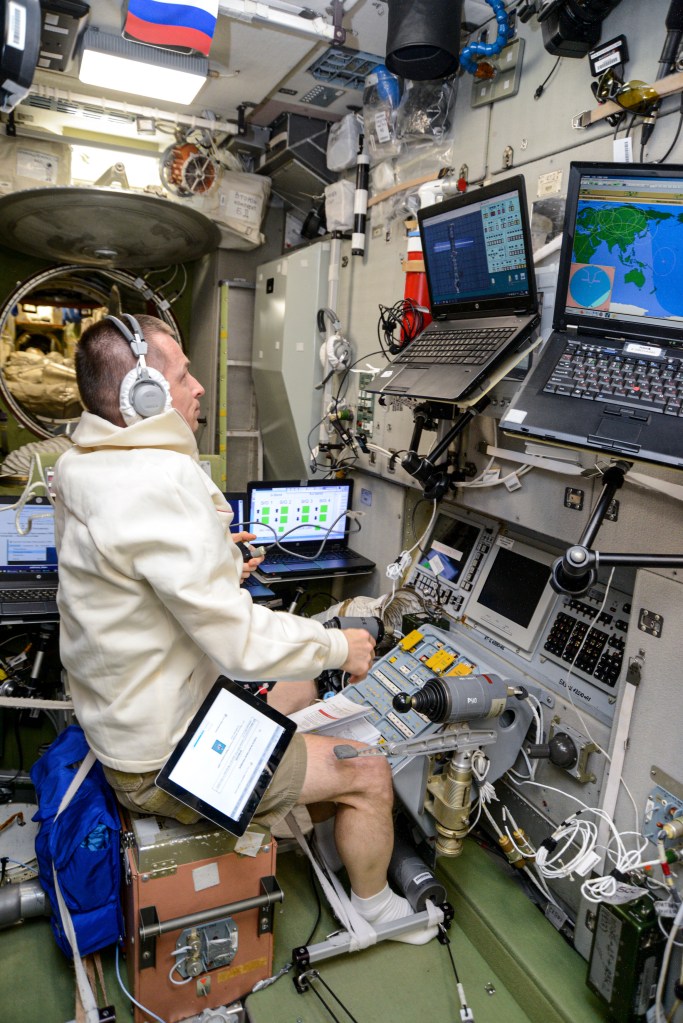
In addition, the Soyuz spacecraft can be docked to the ISS manually by the docking system called the Tele-Robotically Operated Rendezvous unit (TORU). This manual system serves as a backup to Kurs-NA in emergency situations and is located inside the Zvezda service module.


